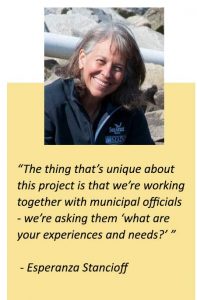Helping Coastal Communities Weather the Storms
Like indoor plumbing, culverts are easy to take for granted until they fail. That’s likely to happen more often as more intense and frequent storms drench New England. Excess storm water runoff can quickly overwhelm aging and undersized culverts. The result: washed out roads, flooded down towns, and other damage that claims lives, disrupts businesses and costs millions of dollars to repair.
Graduate student Alexander Gray and SSI researcher Shaleen Jain review a map incorporating survey results from a questionnaire sent to municipal officials in Maine’s coastal towns and communities.
For instance, the Patriot’s Day Storm of 2007 caused an estimated $45 million in damage to roads and other infrastructure. More recently, a thunderstorm that dumped eight inches of rain in western Maine this summer caused one death and more than $4 million in damage in the town of Brownville alone.
Maine’s coastal communities are particularly vulnerable to wetter and wilder weather, and that has people like Lincolnville Town Administrator David Kinney anxiously trying to figure out how to prepare. “We can respond relatively quickly in a crisis if we can obtain the materials,” Kinney says of repairing failed culverts. “But we’d prefer not to act in a crisis mode and do some planning instead.”
SSI researchers Shaleen Jain, Esperanza Stancioff and graduate student Alexander Gray have teamed up to help Lincolnville and other coastal communities better understand and prepare for the potential local impacts of climate change. They are developing new tools to help town officials plan, prioritize and better budget for storm water control methods like culvert work in order to prevent or minimize damage from future storms—potentially saving lives and millions of dollars.
“Our goal is to help towns make the best decisions with the best available information in the face of uncertainty,” says Jain, UMaine assistant professor of civil and environmental engineering.
When the SSI team asked Kinney and officials in 70 other Maine coastal communities what they most needed help with in adapting to climate change, planning and managing culvert work was at the top of their list. The information to do so, however, has been tough to track down at best and nonexistent at worst.
Culvert work, for instance, is regulated by various local, state and federal agencies, which often operate on different timetables. At the same time, current climate science and models are often too vague to be useful to local decision-makers and little place-based information exists. Add to this the sheer number of culverts in Maine—more than 100,000 under public roads—and it’s clear that even officials like Kinney who want to be proactive lack the tools.
That’s what the SSI team aims to change. They are creating new computer tools that combine data on everything from culvert governance to climate, land use and landscape information to help towns to plan and prioritize culvert work in the face of climate change. The researchers are designing these tools to respond to specific needs that towns have identified, including mapping culvert locations, scheduling maintenance, estimating the size of needed culverts, analyzing replacement and costs, and identifying funding sources, as well as obtaining forms and applications for permitting.
The researchers are working closely with Maine coastal towns to make sure these new tools are usable and relevant even as they’re being developed. “One very important aspect of this project is that we’re working together with municipal officials—we’re asking them, ‘what are your experiences and needs?’” says Stancioff, extension associate professor, University of Maine Cooperative Extension and Sea Grant, who has worked with Maine communities for 24 years. “The other important aspect is that Shaleen is right there at the table, bringing his expertise in the biophysical sciences. He’s engaged with the community and not just sitting in his lab.”
Ultimately, the team’s findings will help reduce uncertainty for David Kinney and others who are seeking ways to help their communities better weather the coming storms. Although the researchers are focusing on coastal communities—major economic engines in a state that relies on tourism—the goal is reasearch that will be relevant for towns throughout Maine and the nation. “The more knowns we have, the better our ability to get decisions right that have long-term implications for the future of our towns,” Kinney says.

